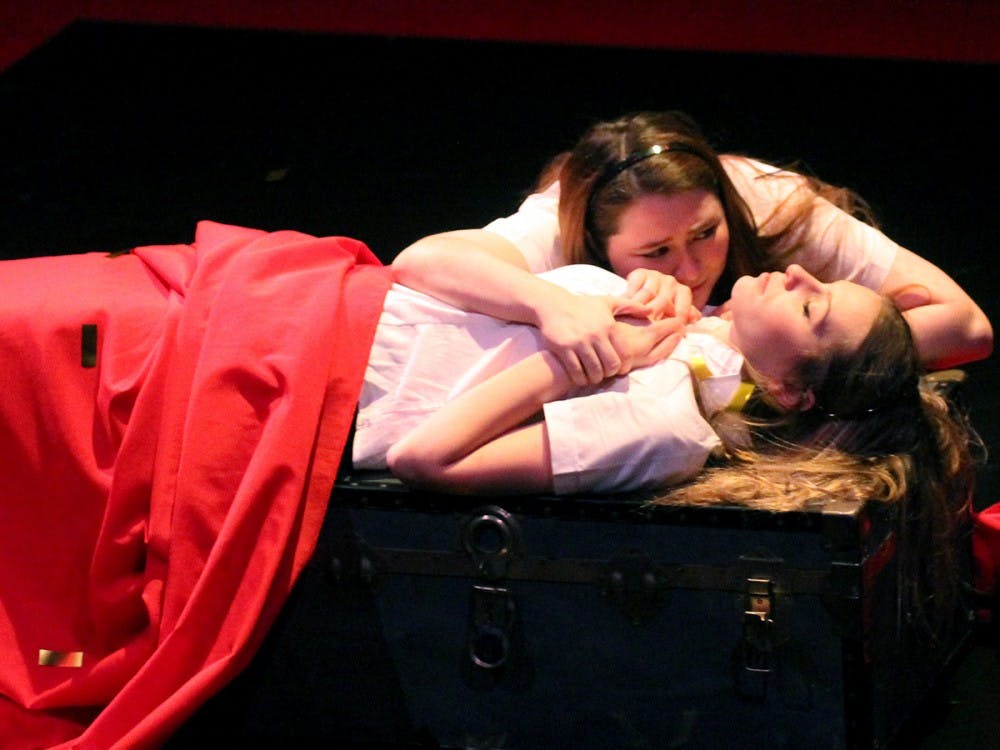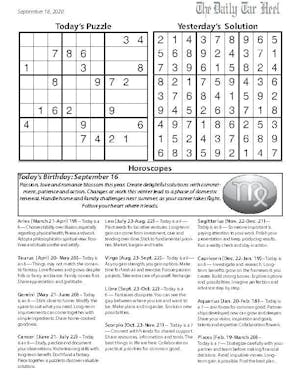ktc’s “Shakespeare’s R&J”
Female Cast: Friday at 8 p.m.; Male Cast: Saturday at 8 p.m.
????
Joe Calarco’s “Shakespeare’s R&J” is an engaging modern riff on the Bard’s classic tale of forbidden love, with talented actors and dynamic direction. Kenan Theatre Company’s production features two casts — one male, one female — in rotating repertory this weekend.
Four young students struggle through the rigors of Catholic boarding school in 1964: they conjugate Latin, say their catechisms, and dictate conventional gender roles with equal rote vigor. At night, the students find solace in Shakespeare’s most sensual play: “Romeo and Juliet.” Their rebellion takes the form of play-acting, drumming, stomping, and exploration of taboo homosexuality. When two students emerge as exclusively playing Romeo (Mary Stewart Evans and Allen Tedder) and Juliet (Abigail Coryell and William Foote), it becomes obvious that their attraction is genuine. Under the guise of acting the young pair explores forbidden emotions, while the other students — disturbed at this development — use their own characters to tear the lovers apart.
One of the greatest challenges of the piece is that the actors must deliver classic lines in a manner that makes them resonate with a modern audience, while convincing them that the actors are young students. Here, the female cast excels. The female production is rife with modernized intonations that bring the text both closer to both the audience and Shakespeare’s original intent, garnering laughs and engaging the audience. Though the cast has clearly mastered the meaning of their material, they shrewdly break up their dialogue with intentional fumbling that reminds the audience of their age. The production sizzles with sexual tension, and fully realizes the raw desire that drives Shakespeare’s plot along.
The male cast tackles all the familiar tropes with boyish enthusiasm, snorting at sexual puns and going all out during the well-choreographed fight scenes. They play female characters at first mockingly, but gradually fall into more natural and convincing portrayals that are thoroughly believable — notably, Foote’s Juliet. They deliver their lines passionately, though not with the same clarity and precision of the female cast. The subtext of the students’ “real-life” relationships is made crystal clear without being overemphasized, and the initial bumbling embraces of Romeo and Juliet are endearing.
The nurse, played by Angel Giddens and Ben French, is a comedic crowd favorite in both productions, with her rambling rants and inexhaustible store of anecdotes. Student 3, played by Camille Oswald and Hunter Gray, is an interesting character whose emotional roller coaster is adeptly portrayed in both casts. Oswald was particularly heart wrenching in reaction to the developing relationship between Romeo and Juliet, and the added layer of her apparent jealousy made the already hot-blooded show even more volatile.
“R&J” is an intentionally stripped-down production that directs attention to the text and subtext instead of its design elements. The set is necessarily minimal — a trunk, four chairs, and a red outline of a square painted on the black floor of the Kenan Theatre — and the primary prop is a length of red cloth that serves effectively as weaponry, clothing, blood, and more over the course of the show. The lighting gracefully propelled the show forward with subtle shifts and the uniform costuming was cleverly extended to the production crew, who wore matching Catholic school uniforms at the tech table that was situated in front of a giant wooden cross. While the rest of the design elements were cohesive, incidental music threaded throughout the show detracted from the realism of several scenes. Likewise, the use of golden confetti during the death scenes was pretty but distracted the audience from the drama.
“R&J” is part play, part dance, with the actors in near constant motion as they move between the play and reality. Directors Katie Chelena and Nathaniel Claridad both did an impressive job of blocking their shows in the round, never letting any side of the audience feel left out for too long. Though the directors approached the text in different ways both did so with clear intention, tight choreography, and raw realism. Both created compelling sub-textual narratives that served as a poignant reminder that society will always be prone to tragedy if we are closed-minded about the nature of love.
arts@dailytarheel.com
To get the day's news and headlines in your inbox each morning, sign up for our email newsletters.





